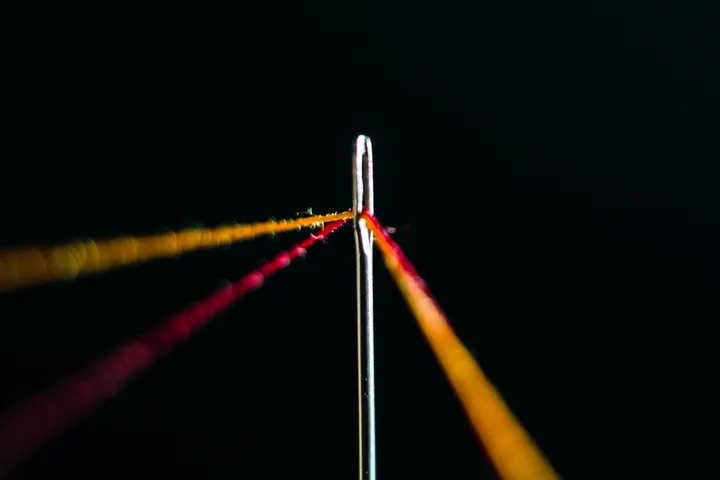问题引入:实现如下效果
两个方块的追逐效果,使用 css3,实现起来没什么难度:
<div id="container">
<div id="first"></div>
<div id="second"></div>
</div>#container {
position: relative;
width: 320px;
height: 320px;
border: 1px solid #ccc;
}
@-webkit-keyframes run {
0% {
left: 0;
top: 0;
}
25% {
left: 220px;
top: 0;
}
50% {
left: 220px;
top: 220px;
}
75% {
left: 0;
top: 220px;
}
100% {
left: 0;
top: 0;
}
}
@keyframes run {
0% {
left: 0;
top: 0;
}
25% {
left: 220px;
top: 0;
}
50% {
left: 220px;
top: 220px;
}
75% {
left: 0;
top: 220px;
}
100% {
left: 0;
top: 0;
}
}
#first {
width: 100px;
height: 100px;
background: orange;
position: absolute;
-webkit-animation: run 1.6s 0.8s infinite;
animation: run 1.6s 0.8s infinite;
}
#second {
width: 100px;
height: 100px;
background: red;
position: absolute;
-webkit-animation: run 1.6s infinite;
animation: run 1.6s infinite;
}用到了 css3 的 animate 属性,不是很复杂。不过出于兼容性的考虑,我们决定使用 jquery 的 animate 方法来重新实现。
简单粗暴地多次使用 $.animate
可以看到,每个方块的运动都可以分解成四步,每一步都是向一个方向运动。于是如果要用 $.animate 来实现,可以在一个循环里,依次调用四遍 $.animate 来实现:
#container {
position: relative;
width: 320px;
height: 320px;
border:1px solid #ccc;
}
#first {
width: 100px;
height: 100px;
background: orange;
position: absolute;
left: 0;
top: 0;
}
#second {
width: 100px;
height: 100px;
background: red;
position: absolute;
right:0;
bottom:0;
}const $first = $('#first');
const $second = $('#second');
(function firstMove() {
$first.animate(
{
left: 220,
top: 0
},
400,
'linear',
() => {
$first.animate(
{
left: 220,
top: 220
},
400,
'linear',
() => {
$first.animate(
{
left: 0,
top: 220
},
400,
'linear',
() => {
$first.animate(
{
left: 0,
top: 0
},
400,
'linear',
() => {
firstMove();
}
);
}
);
}
);
}
);
})();
(function secondMove() {
$second.animate(
{
bottom: 0,
right: 220
},
400,
'linear',
() => {
$second.animate(
{
bottom: 220,
right: 220
},
400,
'linear',
() => {
$second.animate(
{
bottom: 220,
right: 0
},
400,
'linear',
() => {
$second.animate(
{
bottom: 0,
right: 0
},
400,
'linear',
() => {
secondMove();
}
);
}
);
}
);
}
);
})();这种实现简单粗暴。我写的这段代码回调链太深了,不好看。有比我更熟悉 jquery 的朋友不使用 complete 回调,而是直接 $.animate().animate() 这样的调用链,效果一样,代码会短很多。不过 jquery 代码美化优化什么的不是今天的重点。重点是什么?学习缓动函数。
缓动函数(animation easing)
缓动函数是用来描述动画效果,在 jquery 中,实现了两种,分别是 linear 和 swing。linear 效果就是没有效果,动画速度是均匀的,呈线性变化。swing 呢,动画效果呈线慢-快-慢的变化。swing 也是 $.animate 的默认动画效果。
或许仅仅这么说还是难以让人理解缓动函数在干什么,那就参考一下下面来自 jquery ui 的例子:
或者参考 jquery easing plugin。
回到 jquery ui 提供的各个缓动函数示意图上,对于任意一张示意图,横向表示时间,纵向表示动画变化量。当斜率越大时,表示此时动画速率越快。
我们定义几个变量和常量来标记一下:动画起始变化量为 ,为方便计算,定义为常数0;动画结束和起始时的变化差值(总变化量),为方便计算,定义为常数1;动画持续时间 ;动画已进行时间 ;动画进行的进度 ,它等同于 ;当前变化量 ,jquery 中这样定义:
从上面的效果中随便挑一个出来看看是如何实现的吧:
function easeOutBounce(progress, currentTime, begin, change, duration) {
if ((currentTime /= duration) < 1 / 2.75) {
return change * (7.5625 * currentTime * currentTime) + begin;
}
else if (currentTime < 2 / 2.75) {
return change * (7.5625 * (currentTime -= 1.5 / 2.75) * currentTime + 0.75) + begin;
}
else if (currentTime < 2.5 / 2.75) {
return change * (7.5625 * (currentTime -= 2.25 / 2.75) * currentTime + 0.9375) + begin;
}
else {
return change * (7.5625 * (currentTime -= 2.625 / 2.75) * currentTime + 0.984375) + begin;
}
}说到这儿,我想该插一点相关话题。熟悉 css3 的朋友会知道,css3 的动画也有缓动函数,不过换了个名字,叫 timing function。在 transition 中是 transition-timing-function,在 animate 里是 animate-timing-function。主要支持的动画有 ease、linear、ease-in、ease-out、ease-in-out 等。那如果想要的动画不在浏览器默认支持的列表中怎么办?css3 也是支持自定义 timing-function 的,不过不同于 jquery 的 easing function,timing function 并不是描述特定时间下的动画量,而是直接描述上面我们看到的曲线图。timing function 允许使用三次贝塞尔曲线方程描述动画曲线。三次贝塞尔方程接受4个点的参数:
cubic - bezier(P0, P1, P2, P3);但在 css 的 timing function 场景下,P0 点就是(0, 0),P3 点就是(1, 1)。于是变量就只剩下两个点的坐标,调用方式就变成了:
cubic - bezier(P1x, P1y, P2x, P2y);在 W3C 的规范中,定义了这四个点的纵横坐标都需要在0和1之间,这也就意味着无论怎么变化,曲线上所有的点都必须在这个1*1的正方形内,对比上面 jquery ui easing 的曲线图,我们可以确认像 elastic 这类的效果,使用 timing-function 就无能为力了。
想多了解一下 css3 的 timing function,不妨到这个网站上自己动手试验一下。
编写 easing function
说了半天的 timing function,终于又回到 easing function 上来了。自己动手写 easing function,那自由度,无边无际。从上面的介绍中,我们往往会有这样一个错觉,progress = 0 时,eased = 0;progress = 1 时,eased = 1。timing function 中,因为 P0 和 P3 是定死的,所以这条一定成立,但在easing function中,其实并没有这个限制。
什么意思?以我们开篇的动画为例,我们看一个方块从左上角运动一圈的轨迹。先说水平方向上,progress < 0.25 时,left 属性从 0px 变成 220px;0.25 <= progress < 0.5 时,left 保持 220px;0.5 <= progress < 0.75 时,left 属性从 220px 变成 0px;0.75 <= progress < 1时,left 保持 0px。再看竖直方向上,progress < 0.25 时,top 保持 0px;0.25 <= progress < 0.5 时,top 从 0px 变成 220px;0.5 <= progress < 0.75 时,top 保持 220px;0.75 <= progress < 1 时,top 从 220px 变成 0px。那么这个过程反映成 easing function 就是:
function horizontal(progress) {
if (progress < 0.25) {
return progress * 4;
}
else if (progress < 0.5) {
return 1;
}
else if (progress < 0.75) {
return (0.75 - progress) * 4;
}
return 0;
}
function vertical(progress) {
if (progress < 0.25) {
return 0;
}
else if (progress < 0.5) {
return (progress - 0.25) * 4;
}
else if (progress < 0.75) {
return 1;
}
return (1 - progress) * 4;
}接下来扩展 jquery 的 easing 效果库:
$.extend($.easing, {
horizontal,
vertical
});在$.animate中就可以像linear或者swing那样使用了:
(function firstMove() {
$first.animate(
{
left: 220,
top: 220
},
{
complete() {
firstMove();
},
duration: 1600,
specialEasing: {
left: 'horizontal',
top: 'vertical'
}
}
);
})();
(function secondMove() {
$second.animate(
{
left: 0,
top: 0
},
{
complete() {
secondMove();
},
duration: 1600,
specialEasing: {
left: 'horizontal',
top: 'vertical'
}
}
);
})();我们通过 specialEasing 这个参数为水平方向和竖直方向指定了不同的动画效果。当然了,在这个场景中,自己写缓动函数并没有降低整体的复杂度,毕竟这个缓动函数逻辑太碎,理解起来肯定比四个 animate 连起来的方式复杂。但我希望能给大家带来一些思路上的启示,为以后可能遇到的问题积累经验。




